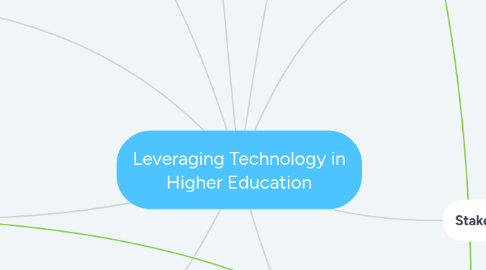
1. Buy In
1.1. Change leadership
1.1.1. Drivers of change
1.1.2. Communication
1.2. Change management
1.2.1. Kotter's model of change management
1.3. Move towards a learning organization
1.4. Considerations for institutional culture
1.4.1. Learning organization is needed
1.5. Systems thinking
2. Artificial Intelligence
2.1. Advising
2.2. Scheduling
2.3. Monitor learner progress
2.4. Recommendations/next steps for those students able to move beyond stated outcomes
2.5. Deakin University
2.6. Learning analytics
3. Barriers
3.1. Stakeholder resistance
3.1.1. Fear or reluctance among administrators and/or faculty
3.2. Human resource cost
3.2.1. Additional IT analyst
3.2.2. Additional support staff
3.3. Maintenance costs
3.3.1. Licensing fees
3.4. Lack of technology skills
3.4.1. Mitigated through training for students, staff and faculty
3.5. Privacy
3.6. Institutional culture
4. Intended Outcomes
4.1. Digital Literacy
4.2. Developing students' digital citizenship
4.3. Enhanced student, faculty, and staff experience
4.4. Going paperless
4.5. Improved quality of learning, operations, & user experiences
5. Staff
5.1. LMS
5.1.1. Advising
5.1.1.1. Notes
5.1.2. Record Keeping
5.1.3. Intervention
5.1.4. Scheduling
5.1.5. Course offerings
5.2. Artificial Intelligence
5.2.1. IT support
5.2.2. Advising
5.2.3. Interventions & monitoring
6. Stakeholders
6.1. Students
6.2. Staff
6.3. Faculty
6.4. Government
6.5. Parents
7. Next Generation Digital Learning Environment
7.1. Interoperability and integration between components and systems
7.1.1. Record keeping
7.2. Personalization
7.2.1. Interventions
7.2.2. Goals
7.2.3. Personal character inventory
7.3. Analytics, advising, and learning assessment
7.3.1. Identification and interventions for students at risk
7.4. Collaboration
7.5. Accessibility & universal design
7.5.1. Mobile application
8. Students
8.1. LMS
8.1.1. Instruction
8.1.2. Assessment
8.1.2.1. Progress
8.1.2.2. Interventions
8.1.3. Goals
8.1.3.1. Career & life goals
8.1.3.2. Goal setting tool
8.2. Artificial Intelligence
8.2.1. Advising
8.2.2. Scheduling
8.2.3. Progress monitored
9. Faculty
9.1. LMS
9.1.1. Instruction
9.1.1.1. Integration of social media in instruction
9.1.1.2. Team collaboration
9.1.2. Delivery options
9.1.2.1. Blended
9.1.2.2. Face to face
9.1.2.3. Online
9.1.3. Assessment
9.1.4. Learning analytics
9.1.5. Planning
9.1.5.1. Course goals & objectives
9.2. Artificial Intelligence
9.2.1. Monitor learner progress
9.2.2. Interventions

